For the last several weeks local media has been reporting that the Emerald Ash Borer has been spotted in central Iowa. The Iowa Department of Natural Resources estimates that there are more than 3 million ash trees in metropolitan areas in Iowa and another 52 million trees in rural woodland areas. The expected loss of these trees could cost more than $2.5 billion over the next two decades.
This Service Alert will provide you with more information about the Emerald Ash Borer and treatment options that will save ash trees from destruction.
What is the Emerald Ash Borer?
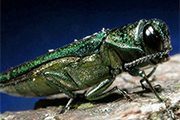
The adult Emerald Ash Borer (EAB) is a green metallic beetle about ½” long and 1/8″ wide. These adult beetles lay eggs in the bark of ash trees which then develop into larvae after hatching. The larvae then feed on the tissue beneath the bark, disrupting the plant’s ability to move water and nutrients. When the larva are fully developed, usually sometime between May and June in Iowa, they emerge from the tree through 1/8″ wide “D-shaped” exit holes. The adult beetles then feed on the foliage of the ash tree before mating and laying the next generation of eggs in the tree.
Once an ash tree is infested with EAB, the tree will be killed in just 2 to 4 years.
How do I determine if my trees are infested?
EAB has historically been difficult to detect in the first years of infestation. The following methods will help you determine if an infestation has occurred in your area:
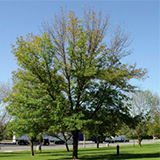
1. Canopy Dieback
The first sign of infestation is dieback in the upper portions of the canopy, which is often overlooked until the damage spreads throughout the tree.
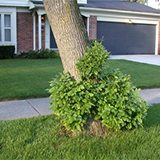
2. Water Sprouts
The second sign of infestation is excessive sucker growth or “water sprouts” and excessive woodpecker feeding.
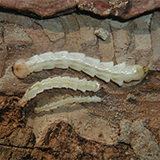
3. Visual Sighting
Infestation may also be confirmed after visual sighting of mature beetles, or by spotting larvae either on top of the bark or immediately below the bark when it is removed.
Can I prevent my trees from being infested?
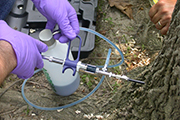
Ash trees can be treated proactively with a simple injection. The injection may be administered anytime the tree is actively growing, but the optimum time is mid-April to mid-June. During these months in Iowa, ash trees have broken dormancy and spring weather patterns provide conditions for active growth. Growth is closely associated with available water in the soil, so a seasonal drought could impact efficiency of uptake of the chemical.
Care of the trees following treatment is important. Once the decision is made to treat ash trees, maintenance is important. Keeping trees in their best possible health and vigor helps to increase the effectiveness of treatments. Proper pruning, fertilization, mulching, and watering during dry periods should be part of the care and maintenance plan.
Injections typically have to be repeated every two to three years. Due to the number of ash trees in Iowa’s native woodlands, it is unlikely that these insects will ever be completely eradicated. As adults, these insects have the ability to fly about two miles. As larva, these pests are often transported in firewood, and may even survive after trees have been removed and run through a wood chipper.
My trees appear to be infested. Can they be saved?
If you have Ash trees that have already been infested, reactive treatment is required. Reactive treatments should only be considered for high value trees and only if the tree’s canopy is less than 30% compromised.
The best treatment option is to inject a systemic insecticide with the active ingredient emamectin benzoate into the tree before the insect attacks. Perficut currently is using the “Arbor Jet” injection system with the chemical brand name “Tree-age” (pronounced triage). Injection requires drilling 1/2″ diameter holes in the base of the trunk. Small black “arbor plugs” are seated in the holes to facilitate injection and are left in the tree. The bark will grow around the plugs in a matter of one growing season. A small pressure tank, tubing, and needles are used, and the chemical is drawn into the vascular system of the tree as it moves fluids within the cells from the root system into the canopy.
We have chosen this program because research shows that it is 99% effective at prevention of EAB. Emamectin benzoate is the ONLY product labeled to last two years, all others must be repeated annually.
Is it possible to replace my ash trees?
Perficut is assisting customers to replace ash trees, both proactively and after infestation has occurred. Our tree health team is committed to helping you maintain the health and beauty of your property for years to come.
